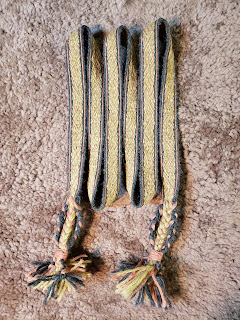Plant-Dyed Mammen Belt
It feels good to finish this project for a dear friend!
This is the Mammen band, which I've posted before, based upon the 10th c find from Mammen, Denmark. Because of the color combination, I've been affectionately calling this one "watermammen." it looks delicious! 🍉
This band is 100% worsted wool, all of which was hand dyed by myself and the person to whom the band is going using period-appropriate materials and techniques. The blue-grey was overdyed in woad then saddened in an iron bath; the rose red was dyed with madder roots; the lime green was dyed with woad then overdyed in weld.
It is just under two yards in length, and because it is going to be used as a belt, I finished the ends in braids then sewed in the ends for strength. The band has been wet-set and is ready to wear!
I wanted to do my very best work for her, and with this band I feel like I have. 🤗
A bit of history:
First excavated in 1868, when the state of this field was different, the Mammen textiles were not treated well or stored properly. Not much study was done until the 1980s when researchers began trying to reconstruct the textiles based upon the fragments that were left. They believed this was a 2-hole weave based upon the surviving thread structure. But in 1990, a researcher named Egon Hansen studied it and determined it was likely that 3 or 4 holes were used, but filled with a vegetable thread (linen) that had not survived.
There are a few different interpretations out there. We know the original was brocaded with gold thread and composed of wool threads.
The pattern used here, which I have posted in the past, was designed by Shelagh Lewins. It uses a missed-hole technique wherein 1 hole in the tablet is left empty; this is generally seen as a more challenging way to weave because it causes the tablets to become rather unruly and creates some challenges in the warp. It is also "threaded-in," meaning the pattern is made by the correct orientation of the tablets, not brocaded.





Comments
Post a Comment